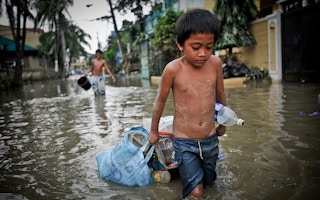With money for action on climate change already in short supply, an estimated $300 billion a year needed to help countries deal with unavoidable climate losses will have to come from innovative new sources, such as a financial transaction tax or carbon tax, researchers say.
Funding for such climate “loss and damage” aims to assist people who lose their land to sea level rise, for instance, or are forced to migrate as drought makes growing crops impossible in some regions.
“What stands out most clearly is that there isn’t currently enough funding to even begin thinking about financing loss and damage, with available climate, development, risk reduction and disaster recovery financing all falling short by an order of magnitude,” said researchers at the Berlin-based Heinrich Böll Foundation.
In a report released at the UN climate negotiations in Bonn, now heading into their second week, researchers said about $50 billion a year would be needed by 2020 to help people who lose their land and culture or are forced to migrate as a result of climate-related problems.
That need would likely hit at least $300 billion a year by 2030, said report authors Julie-Anne Richards, who works in the foundation’s climate justice programme, and Liane Schalatek, the foundation’s North America associate director.
“
What stands out most clearly is that there isn’t currently enough funding to even begin thinking about financing loss and damage, with available climate, development, risk reduction and disaster recovery financing all falling short by an order of magnitude.
Researchers, Heinrich Böll Foundation
Such spending would come on top of $100 billion a year in funding by 2020 that richer nations have already promised poorer ones under the Paris Agreement to help them develop cleanly and adapt to the impacts of climate change.
But that pledge is “very unlikely” to be met, the report said, with US President Donald Trump, for instance, saying he will not hand over $2 billion in US payments promised to the international Green Climate Fund.
To find new cash to pay for “loss and damage”, innovative financing such as a new carbon tax, aviation tax or financial transaction tax should be considered, the authors said. Such money “could fairly and predictably fill much of the loss and damage finance gap”, the report said.
No new body should be created to handle and disperse the funds, however, they said, with money instead put through existing organisations such as the Green Climate Fund or the Global Environment Facility.
Harjeet Singh, who heads climate change policy for charity ActionAid, also said that setting up a new loss and damage funding body made no sense.
“It’s so tedious to set up an institution and get it going, and make sure the money reaches the intended people. It does make sense to use the existing mechanisms to transfer the money,” he told the Thomson Reuters Foundation in a telephone interview from Bonn.
The problem is that funding for loss and damage will be increasingly urgently needed as action to curb climate change falls short and efforts to adapt to more severe impacts struggle as well.
“Sea level is rising much faster than expected,” he said. “How will the humanitarian community deal with the increasing number of climate-related disasters?”
Finding the political will to deal with climate change – and the funds to deal with rising unavoidable losses – needs to be a priority as negotiators move toward putting the Paris Agreement on climate change into effect in 2018, the report said.
Delays in acting on climate change will not only lead to rising costs from losses and damage, the authors said, but also “cause unimaginable suffering and guarantee a less stable, more poverty- and inequality-stricken, more unhappy and less sustainable world”.
This story was published with permission from Thomson Reuters Foundation, the charitable arm of Thomson Reuters, that covers humanitarian news, climate change, resilience, women’s rights, trafficking and property rights. Visit http://news.trust.org/climate.








